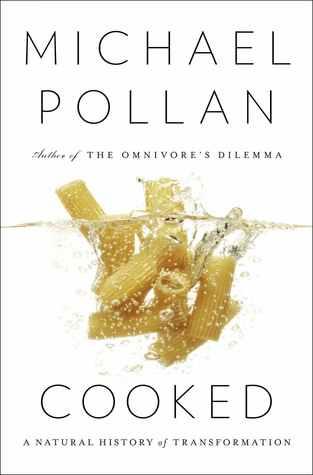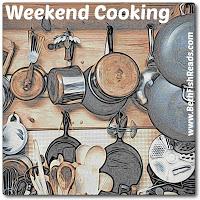Book: Cooked: A Natural History of Transformation by Michael Pollan
Genre: Nonfiction
Publisher: The Penguin Press
Publication date: 2013
Pages: 468
Source: Library
 Summary: Cooked by Michael Pollan looks at the transformation of ingredients into food by the four elemental forces — fire for barbecue, water for braises, air for bread, and earth for fermented products like sauerkraut and cheese.
Summary: Cooked by Michael Pollan looks at the transformation of ingredients into food by the four elemental forces — fire for barbecue, water for braises, air for bread, and earth for fermented products like sauerkraut and cheese.
While covering these topics, he looks at deeper issues that surround cooking, including the basic question “why cook?” Here’s one answer from the introduction:
Cooking has the power to transform more than plants and animals: It transforms us, too, from mere consumers into producers. Not completely, not all the time, but I have found that even to shift the ratio between these two identities a few degrees toward the side of production yields deep and unexpected satisfactions. Cooked is an invitation to alter, however slightly, the ratio between production and consumption in your life. The regular exercise of these simple skills for producing some of the necessities of life increases self-reliance and freedom while reducing our dependence on distant corporations. Not just our money but our power flows toward them whenever we cannot supply an of our everyday needs and desires ourselves. And it begins to flow back toward us, and our community, as soon as we decide to take some responsibility for feeding ourselves. p. 23
Thoughts: Since Cooked has four parts, I’ve written my review that way. Here are the first two parts:
- Book Review: Cooked by Michael Pollan (Part 1), about barbecue with interesting observations about race in America.
- Book Review: Cooked by Michael Pollan (Part 2), about braising with interesting observations about gender and cooking.
Part 3 is about bread, a food that once had such a close association with hearth and home that, even today, the smell of freshly baked bread brings a rush of emotions that may or may not have any real memory of home baking attached to it. At the same time, bread is so industrialized that it has its own saying: The greatest thing since sliced bread. (I just learned from Wikipedia that sliced bread was invented in my home state of Missouri in 1928: Sliced bread).
Pollan did his explorations of bread baking using a sourdough starter and, initially, white flour. Whole wheat, while healthier, makes baking more challenging and not just for home bakers. Commercial bakers cover up bitter tastes with extra sweeteners, according to Pollan. For my way of eating, commercial loaves have way too much sodium and whole wheat breads, for reasons I still don’t know, have more than white breads.
Although I’ve used sourdough starter in the past, my current exploration of bread is around grinding my own flour as I wrote about last fall: Book Review: Flour Power by Marleeta F. Basey. I bought a grain mill. Although Pollan didn’t grind his own flour, he visited a baker who did:
The bread was a revelation. I felt as though I was tasting wheat for the very first time. The flavor held nothing back; it was rich, nutty, completely obliging in its sweetness. p. 276
Yep. It’s that good.
Pollan explains how making a good loaf of whole wheat bread is complicated even more by our white flour civilization. Even the wheat is all bred for “a giant super-white endosperm and a hard coat of bran.” (p. 278)
This makes me think, though, that there must be farmers growing heirloom wheat that I could run through my mill to make an even more superior flour. Pollan’s descriptions of bread-baking make me want to replace my yeast with sourdough starter and bake the loaves in the oven instead of my bread machine. But, first, I want to experiment more with my grain mill — I have some non-wheat grains to try that I bought when Whole Foods had a sale on their bulk foods. And, I want to investigate other sources for wheat berries. That sounds like a good fall and winter project to document in Weekend Cooking posts.

Do you bake bread? What experiments have you tried that produced good results in your kitchen?
Look for more cooking posts at Weekend Cooking hosted by Beth Fish Reads.

